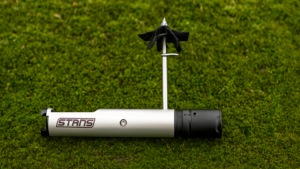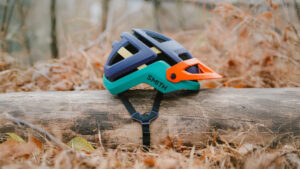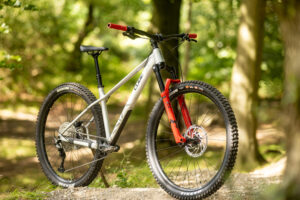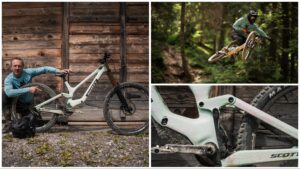For this marathon race-focused Lapierre, pedalling efficiency is a top priority. Does it cut it as a lightweight trail shredder though?
Lapierre XRM 6.9 review
For the XRM 6.9, Lapierre takes the full carbon frame from its World Cup XC bike, the XR, adds a longer travel fork, a dropper post and slightly burlier components, and hey presto, Lapierre has a marathon/down country bike. But has it worked? Before we answer that, let’s take a closer look at the details.
Frame travel on the XRM is quoted at 110mm, but we measured it at 95mm, which is an alarmingly big discrepancy. It used a flex stay design to save weight where the carbon back end is big and burly, the wide main pivot stance and deep chainstays providing ample stiffness.

XRM 6.9 is equipped with a 120mm travel SID fork and 100mm stroke dropper post
The front end comes in four frame sizes, S to XL and the standover height is really good for what is essentially a hopped up XC bike. In terms of reach, the Lapierre is conservative: 458mm on the size L, favouring longer 70mm stems on the L and XL to get the right fit, rather than adding length to the frame and reducing the stem lengths. It seems to work pretty well here though, as the overall fit felt really good. Thankfully the angles are less reserved, the 65.8º head angle providing a predictable steering response, while the 74.6º seat angle stretches out the cockpit and works well with the shorter front end.
Uniting the carbon front and rear end is a short alloy linkage and shock yoke; where a co-pivot design connects both to the top of the seat stays. Again, just like the flex stay rear end, this means fewer pivots, bearings and hardware and equates to less weight, so all in the XRM 6.9 is a scant 13.19kg (29.08lb).
Other neat features include a removable rear axle lever with a bottle opener, internal cable routing and a 100mm dropper post that puts the saddle securely between your thighs when descending, so you still have some control over the bike, handy given how light it is.

A handlebar mounted remote lock out is standard kit
Suspension
With the 50mm stroke RockShox SID Luxe shock promising 110mm but delivering 95mm of travel, the Lapierre has a very low leverage ratio. So low in fact, when you combine it with the extra spring force required to compress the carbon flex stays, at 80kg, we were only running 125psi in the shock to achieve the desired 25% sag. Those are just numbers though, and out on the trail we were still able to use all of the travel with regularity.
If you’re new to the SID Luxe shock, it’s worth knowing that the rebound dial is a 2.5mm Allen key head hidden inside the compression dial, in this instance a lock out remote, and if you didn’t know it was there you could easily overlook it. We only used one third of the available rebound damping, so there’s plenty of scope to accommodate lighter or heavier riders.

A dropper post lever and suspension remote result in a busy cockpit
There’s no such setup issues with the RockShox SID 35 fork. It has a super sensitive action of the top and good control once you get deeper into the 120mm travel. Factor in the stiffness of the 35mm chassis and pound for pound it’s quite possibly the best fork in the RockShox range right now.
Both the fork and shock are connected to the SRAM handlebar mounted lockout. So rather than having adjustable compression damping, the compression settings on the fork and shock are binary: open or locked. The remote sits above the bar, as it’s been crowded out by the dropper remote, and while the unit feels plasticy, it functions really well. Yes, it’s a stretch if you forget to open up the suspension before dropping into a technical trail, but all you need to do is find the release lever and it pops the suspension open with minimal effort.

Dropper posts are a welcome sight on these more capable XC bikes
Components
Combine the pitter patter action of the SID fork with the size specific Lapierre Fit Grips, that have more rubber on top to provide extra cushioning without becoming a handful, and the control and comfort up front is impressive.
The stem came fitted with a negative rise, and even in the highest position, it felt a little too low, relative to our feet. Fine for grinding up the steepest climbs, not ideal for navigating technical trails. Flipping the stem instantly fixed that though, and we were still able to keep the front end down and on-line even when faced with a wall of a climb. Having a slightly higher front end really helped centre our weight on the bike though, allowing us to load the rear suspension more readily and ride more dynamically.
Thanks to the relatively high 431mm BB, pedal clearance, even with the longer 175mm SRAM crank arms, was never an issue. We did find the gearing less than adequate on the Lapierre though. Not the action of the SRAM GX Eagle 12 speed shifter and derailleur, as both offer rapid precise shifts even in muddy conditions. No, it was more about the ratios. Lapierre has paired a 32t chainring with an 11-50t cassette, so it has less range than the more expensive and lighter 10-52t Eagle options. As such, it’s harder to keep heavy legs spinning on longer rides with steeper climbs. The cheapest solution would be to fit a 30t chain ring but you’ll run out of high gears pretty quickly on such a fast bike. Ideally, the Lapierre would come with the full range Eagle cassette, as you gain gearing at both ends of the spectrum and save weight.

A minimalist chain guide adds additional security
The Maxxis Ardent Race/Recon Race tyre combo keeps the pace high and rolling resistance low. And while it’s easy to take one look at the 160mm rear rotor and assume you’d be under gunned with the twin-piston SRAM Level T brakes, we had no issue locking the rear wheel up, even on really fast sections of trail. So the stopping power of the brakes clearly isn’t the limiting factor here, traction is.
Performance
For a bike with so many cables, remarkably, none of them rattle inside the carbon frame or of each other. And when combined with the rubberized chain stay protection to dampen chain slap, all you hear ripping down a trail on the XRM 6.9 is the breeze rushing past your ears and the sound of the tyres rumbling along the ground beneath you. As such, the Lapierre offers a blissfully silent ride.

The rear SRAM Level T brake caliper is tucked away neatly
The Lapierre feels remarkably solid for a bike with a more demure stature and sub 30lb build weight. There’s none of the wayward handling traits you get on some hopped up XC bikes, the stout rear end ensuring that power delivery is every bit as direct as the steering response.
Stand up to sprint, and there’s a small amount of rear suspension movement. Not enough to have you reaching for the remote lockout lever, but just enough to maintain traction on rougher climbs. The rear suspension is not very dynamic though, so while this helps maintain a stable ride feel, it limits traction, control and the ability to ride really fast when the trails are anything other than billiard table smooth.
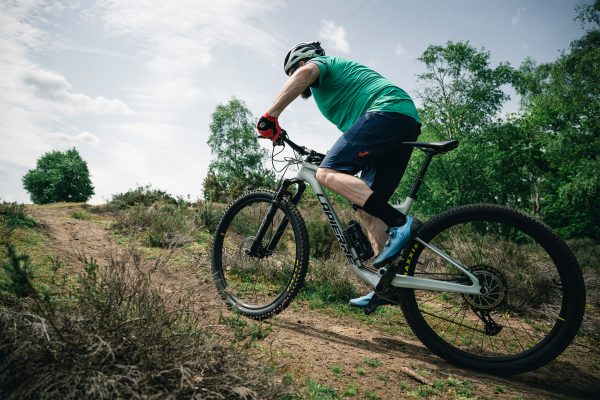
Climbing efficiency can be boosted with the remote rear shock lockout
A lot of short travel flex stay bikes feel springy and lack control. Not the Lapierre XRM 6.9. In fact Lapierre has gone a little too far in the opposite direction, the XRM 6.9 is steadfast under pedalling but lacking the suspension sensitivity needed to really boost traction for true trail riding.
It still feels marginally more capable than your average marathon bike though, and for just under £4k for a carbon frame with a decent specification it’s good value. Ultimately, the Lapierre is a great option for anyone wanting the speed and efficiency of a true XC/marathon bike, but with a slightly broader skill set.

The XRM 6.9 is a versatile machine that’s happy with or without a race number fitted
Verdict
A lot of short travel flex stay bikes feel springy and lack control. Not the Lapierre XRM 6.9. In fact Lapierre has gone a little too far in the opposite direction, the XRM 6.9 steadfast under pedalling but lacking the suspension sensitivity needed to really boost traction for true trail riding. It still feels marginally more capable than your average marathon bike though, and for just under £4k for a carbon frame with a decent specification, it’s a great option for anyone wanting the speed and efficiency of a true XC/marathon bike, but with a slightly broader skill set.










